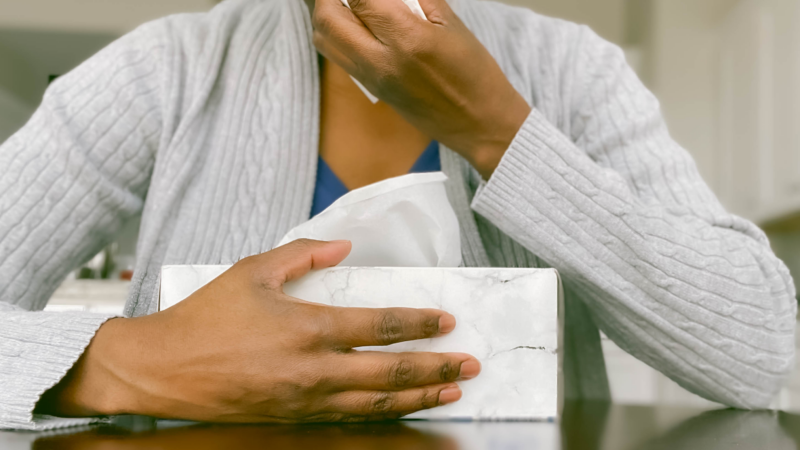Flu cases rise again, while COVID takes a back seat
Many people are feeling lousy right now as the winter stew of respiratory viruses simmers. But there are a couple of unusual trends driving all the coughing, sneezing and fevers this year.
First, the good news: This winter’s COVID-19 surge has been mild.
“This year’s winter wave is low compared to previous winters,” says Caitlin Rivers, an epidemiologist at the Johns Hopkins Bloomberg School of Public Health. “This is the smallest winter wave we’ve had since the pandemic began.”
The weekly rate at which people are getting hospitalized for COVID this winter peaked at about 4 per 100,000, compared with about 8 per 100,000 last season, about 11 per 100,000 in the 2022-2023 season and 35 per 100,000 in the 2021-2022 season, according to data from the Centers for Disease Control and Prevention.
One possible explanation for the relatively mild COVID winter is that the U.S. experienced an unusually intense summer COVID wave that also started relatively late. As a result, many people may still have some immunity from when they had COVID during the summer.
“There are less people available to get infected because they had a recent boost in immunity,” says Rivers.
Flu may be crowding out COVID
At the same time, no new variant has evolved that’s any better at getting around the immunity people have built up, according to Aubree Gordon, an epidemiologist at the University of Michigan School of Public Health.
Another possible factor is “viral interference,” she says. That’s a phenomenon that occurs when the presence of one virus pushes out other viruses. Some scientists think that may be one of the reasons there a decrease in infections with other respiratory viruses, such as flu and RSV, during the early, heavy COVID waves.
“It’s possible that viral interference is playing a role this year,” Gordon says. “There’s a lot of influenza circulating. It may generate some non-specific immunity — some nonspecific protection, which then prevents people from getting other respiratory infections, such as SARS-CoV-2 — sort of crowds it out.”
That said, COVID is still spreading widely, causing people to miss work, children to miss school and even making some people so sick they end up in the hospital or die. So Rivers says people shouldn’t let down their guard, especially because taking steps to protect against COVID can also protect against other viruses, like RSV and the flu.
Flu rebounds and could stick around
The bad news trend this year is the flu. This year’s flu season started unusually early and has been spreading at high levels around the country. And now, it looks like the U.S. is experiencing a second peak of flu activity this winter.
“Influenza activity first peaked around the turn of the new year — late December, early January. Activity then declined for several weeks in a row, which is usually a sign that the season is on its way out,” Rivers says. “But then it really took an unusual turn and started to rise again. So activity is now at a second peak — just as high as it was at the turn of the new year. It’s unusual.”
The rate at which people were going to doctor for a fever and cough or sore throat, which is one way the CDC tracks the flu, dropped from 6.8% to 5.4%, but then started to rise again, reaching 7 %, according to Rivers.
So the intensity of this year’s flu season could have a long tail, she says. “This could turn out to be an unusually severe flu season,” Rivers says.
The cause of the second peak remains unclear. So far testing hasn’t spotted any signs that the H5N1 flu virus, which has been spreading among poultry and dairy cows, is circulating widely in people, contributing to the second peak.
So the cause remains a mystery, Rivers says. It could just be the kind of natural variation that happens with the flu.
Still, the more people who catch the flu, the greater the chances that people could get infected with both viruses — the regular flu and bird flu. And that could give the bird flu the opportunity to swap genes with the regular flu and evolve into something more dangerous.
“That is certainly a huge concern,” says Gordon. “The danger with flu activity is that we have so many people that are infected with these seasonal viruses that it could increase the chance that you get a co-infection in a person with one of these seasonal viruses and H5N1, which gives the opportunity to generate a new virus that transmits really well from human to human. And that is one way you can get a pandemic.”
‘The Abandons’ is a sudsy soap opera dressed up in spurs and a cowboy hat
On the surface it's a gorgeous, hardscrabble Western, awash in stark landscapes, grubby faces, bar fights and banditry. But scratch away the grime, and you expose the pure, glitzy soap opera beneath.
Sudanese paramilitary drone attack kills 50, including 33 children, doctor group says
Thursday's attack is the latest in the fighting between the paramilitary group, the Rapid Support Forces, also known as the RSF, and the Sudanese military, who have been at war for over two years.
Russia unleashes drone and missile attack on Ukraine as diplomatic talks continue
Russia unleashed a major missile and drone barrage on Ukraine overnight into Saturday, after U.S. and Ukrainian officials said they'll meet on Saturday for talks aimed at ending the war.
Takeaways from the latest special election and what it means for control of the House
There was yet another sign this week of a potential 2026 wave that could hand control of the House of Representatives to Democrats.
West Virginians question National Guard deployments after attack on 2 of their own
Army Specialist Sarah Beckstrom was fatally shot in Washington, D.C., while Air Force Staff Sergeant Andrew Wolfe was seriously wounded. Trump says the deployments are necessary to fight crime, but others disagree.
Trump official signals potential rollback of changes to census racial categories
Trump officials are reviewing changes to racial and ethnic categories that the Biden administration approved for the 2030 census and other federal government forms, a White House agency official says.






